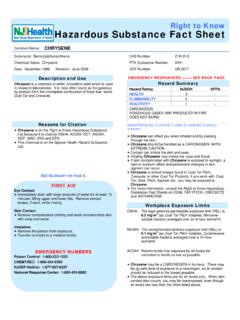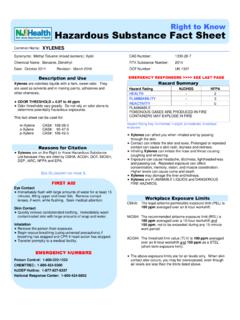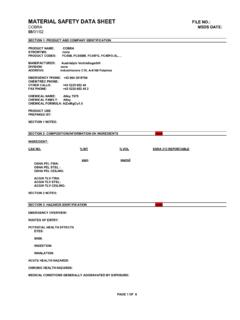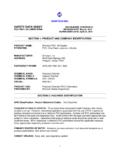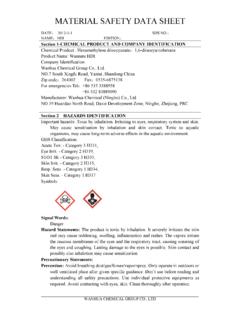Transcription of MATERIAL SAFETY DATA SHEET - Klen International
1 MATERIAL SAFETY data SHEET product Code: D0149: File F:\msdsother\MSDS original vmr\ Page 1 of 5, Issue No 10, Last revision: October 2012, Date of Issue: 18/01/2013 Section 1 Statement of Hazardous Nature, Chemical product and Company Identification CLASSIFIED AS HAZARDOUS ACCORDING TO CRITERIA OF ASCC AND CLASSIFIED AS A DANGEROUS GOOD ACCORDING TO THE ADG CODE. PERTH: Klen International (74) Pty Ltd; 19 Motivation Drive Wangara WA 6065 EMAIL: ABN: 25 008 776 681 FAX: (08)9306 8922 TEL: (08) 9306 8900 CONTACT POINT - Chemist - TELEPHONE (08) 9306 8900 EMERGENCY TELEPHONE NUMBER: A/H (+618) 419 906 672 product Name: LITHARGE Synonyms: Lead monoxide, Lead Oxide; Lead (II) oxide; lead oxide yellow; litharge; massicot, Pigment yellow 46. EC No.: 215-267-0 Molecular Weight: Chemical Formula: PbO product Use: gold assay flux Reach Registration No.
2 : 01-2119531110-62-0053 2. Hazards Identification Emergency Overview: May be fatal if swallowed or inhaled. Causes irritation to skin, eyes and respiratory tract. Neurotoxin. Affects the gum tissue, central nervous system, kidneys, blood and reproductive system NFPA ratings: health = 3; flammability=0; reactivity=0. Global Harmonised Scheme classification: (Annex VI to Regulation (EC) No 1272/2008): H360Df ; Acute H332; Acute Tox. 4 H302; STOT RE 2 H373; Aquatic Acute 1 H400; Aquatic Chronic 1 H410 Potential Health Effects Inhalation: Lead can be absorbed through the respiratory system. Local irritation of bronchia and lungs can occur and, in cases of acute exposure, symptoms such as metallic taste, chest and abdominal pain, and increased lead blood levels may follow. See also Ingestion. Ingestion: POISON! The symptoms of lead poisoning include abdominal pain and spasms, nausea, vomiting, headache.
3 Acute poisoning can lead to muscle weakness, lead line on the gums, metallic taste, definite loss of appetite, insomnia, dizziness, high lead levels in blood and urine with shock, coma and death in extreme cases. Skin Contact: Lead and lead compounds may be absorbed through the skin on prolonged exposure; the symptoms of lead poisoning described for ingestion exposure may occur. Contact over short periods may cause local irritation, redness and pain. Eye Contact: Absorption can occur through eye tissues but the more common hazards are local irritation or abrasion. Chronic Exposure: Lead is a cumulative poison and exposure even to small amounts can raise the body s content to toxic levels. The symptoms of chronic exposure are like those MATERIAL SAFETY data SHEET product Code: D0149: File F:\msdsother\MSDS original vmr\ Page 2 of 5, Issue No 10, Last revision: October 2012, Date of Issue: 18/01/2013 of ingestion poisoning; restlessness, irritability, visual disturbances, hypertension and grey facial colour may also be noted.
4 Aggravation of Pre-existing Conditions: Persons with pre-existing kidney, nerve or circulatory disorders or with skin or eye problems may be more susceptible to the effects of this substance. 3. Composition/Information on Ingredients Ingredient CAS No Percent Hazardous Lead Oxide 1317-36-8 - 100% Yes 4. First Aid Measures Inhalation: Remove to fresh air. If not breathing, give artificial respiration. If breathing is difficult, give oxygen. Get medical attention. Ingestion: Induce vomiting immediately as directed by medical personnel. Never give anything by mouth to an unconscious person. Get medical attention. Skin Contact: Immediately flush skin with plenty of soap and water for at least 15 minutes. Remove contaminated clothing and shoes. Get medical attention. Wash clothing before reuse. Thoroughly clean shoes before reuse. Eye Contact: Immediately flush eyes with plenty of water for at least 15 minutes, lifting lower and upper eyelids occasionally.
5 Get medical attention immediately. 5. Fire Fighting Measures Fire: Not considered to be a fire hazard. Explosion: Not considered to be an explosion hazard. Fire Extinguishing Media: Use any means suitable for extinguishing surrounding fire. Do not allow water runoff to enter sewers or waterways. Special Information: In the event of a fire, wear full protective clothing and NIOSH-approved self-contained breathing apparatus with full facepiece operated in the pressure demand or other positive pressure mode. Can produce toxic lead fumes at elevated temperatures and also react with oxidizing materials. 6. Accidental Release Measures Ventilate area of leak or spill. Wear appropriate personal protective equipment as specified in Section 8. Spills: Sweep up and containerize for reclamation or disposal. Vacuuming or wet sweeping may be used to avoid dust dispersal 7.
6 Handling and Storage Store in accordance with Australian Standards AS 4452-1997, Storage and handling of toxic substances. Keep in a tightly closed container, stored in a cool, dry, ventilated area. Protect against physical damage. Isolate from incompatible substances. Areas in which exposure to lead metal or lead compounds may occur should be identified by signs or appropriate means, and access to the area should be limited to authorized persons. Containers of this MATERIAL may be hazardous when empty since they retain product residues (dust, solids); observe all warnings and precautions listed for the product . 8. Exposure Controls/Personal Protection HSIS Permissible Exposure Limits: Lead, metal and inorganic dusts and fumes, as Pb: TWA mg/m3; STEL: nor listed. OSHA Permissible Exposure Limit (PEL): mg/m3 (TWA). ACGIH Threshold Limit Value (TLV): mg/m3 (TWA).
7 A3 animal carcinogen ACGIH Biological Exposure Indices (BEI): 30 ug/100ml, notation B MATERIAL SAFETY data SHEET product Code: D0149: File F:\msdsother\MSDS original vmr\ Page 3 of 5, Issue No 10, Last revision: October 2012, Date of Issue: 18/01/2013 (see actual Indices for more information). For lead, inorganic: -NIOSH Recommended Exposure Limit (REL): mg/m3 (TWA) Ventilation System: A system of local and/or general exhaust is recommended to keep employee exposures below the Airborne Exposure Limits. Local exhaust ventilation is generally preferred because it can control the emissions of the contaminant at its source, preventing dispersion of it into the general work area. Personal Respirators (AS1715/1716 Approved): If the exposure limit is exceeded, a half-face high efficiency dust/mist respirator may be worn for up to ten times the exposure limit or the maximum use concentration specified by the appropriate regulatory agency or respirator supplier, whichever is lowest.
8 A full-face piece high efficiency dust/mist respirator may be worn up to 50 times the exposure limit, or the maximum use concentration specified by the appropriate regulatory agency or respirator supplier, whichever is lowest. For emergencies or instances where the exposure levels are not known, use a full-facepiece positive-pressure, air-supplied respirator. Skin Protection: Wear impervious protective clothing, including boots, gloves, lab coat, apron or coveralls, as appropriate, to prevent skin contact. Eye Protection: Use chemical SAFETY goggles and/or full-face shield where dusting or splashing of solutions is possible. Maintain eye wash fountain and quick-drench facilities in work area. Other Control Measures: Eating, drinking, and smoking should not be permitted in areas where solids or liquids containing lead compounds are handled, processed, or stored.
9 Blood lead levels should be monitored for all personnel potentially exposed to lead dusts. 9. Physical and Chemical Properties Appearance: Red or reddish yellow powder (yellow form stable above 489oC). Odour: Odourless. Solubility: Insoluble in water ( water). Soluble in acetic acid, nitric acid and alkali Specific Gravity: pH: Strong base % Volatiles by volume @ 20oC: 0 Boiling Point: 1477 C. Melting Point: 888 C Vapour Density (Air=1): No information found. Vapour Pressure (mm Hg): 10 at 1085 C Evaporation Rate (BuAc=1): No information found. 10. Stability and Reactivity Stability: Stable under ordinary conditions of use and storage. Hazardous Decomposition Products: Toxic metal fumes may form when heated to decomposition. Hazardous Polymerization: Will not occur. Incompatibilities: Hydrogen peroxide, lithium carbide, chlorine, ethylene, fluorine, sulfides, acetylides, aluminium, strong reducing agents, combustible materials, chemically active metals.
10 Conditions to Avoid: Heat, flames, ignition sources and incompatibles. 11. Toxicological Information Litharge: Acute Toxicity: Oral (dog) lowest LD 1400 mg/kg. Intraperitoneal: rat lowest LD 430 mg/kg. Skin (rabbit, adult) 100mg/24h MLD. Inhalation (human, for Lead) TCLo 10 mg/m3 gastrointestinal effects. Inhalation (rat) lowest toxic concentration 10 continuous. Investigated as a tumorigen and mutagen. MATERIAL SAFETY data SHEET product Code: D0149: File F:\msdsother\MSDS original vmr\ Page 4 of 5, Issue No 10, Last revision: October 2012, Date of Issue: 18/01/2013 Reproductive Toxicity: Lead and other smelter emissions are human reproductive hazards (Chemical Council on Environmental Quality; Chemical Hazards to Human Reproduction, 1981). NOHSC: Repr. ; Repr. Carcinogenicity: For lead and inorganic lead compounds: EPA / IRIS classification: Group B2 Probable human carcinogen, sufficient animal evidence.
